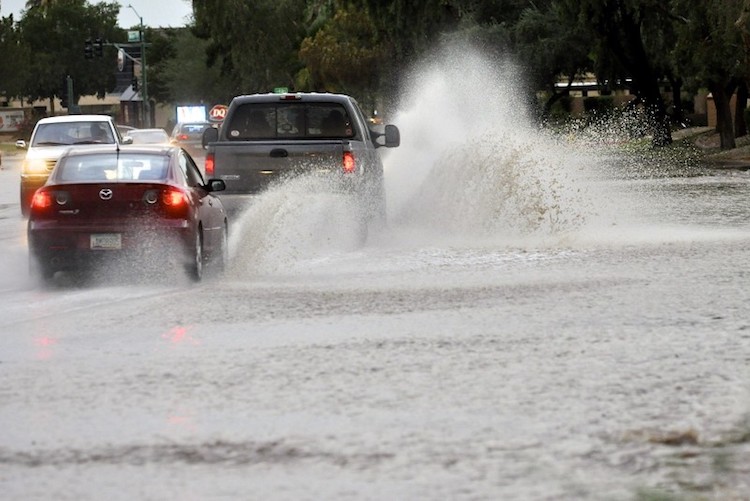- Home
- The Tips & Tricks
- Be Prepared for Monsoon Season

Be Prepared for Monsoon Season
In the desert, storms and flooding can strike quickly and lead to rapidly changing conditions. The desert Southwest experiences seasonal “monsoon” activities during the summer from approximately June 15 through September 30; storms peak between mid-July and mid-August. Here are some helpful reminders and tips to prepare for the Arizona monsoon season.
OUTAGES
Electricity outages can occur and you should be prepared for them. In case of an outage, here are some helpful tips and tools.
If you are an APS customer, you can report an outage anytime online, with their mobile app or by calling (602) 371-3680 (metro Phoenix) or (855) 688-2437 (other areas). You can view the APS interactive outage map to find details on current power outages in your area. Customers can Sign up for text or email alerts to stay informed when there’s a power outage in your area. Plus, receive an estimate on when your power will be back on.
For SRP customers, report an outage online or by calling (602) 236-8888. Visit the SRP website for more information.
Plan now to have these items on hand in case of an outage.
- Place a flashlight and extra batteries in an easy-to-find spot.
- Have a portable battery pack available for your phone so you can continue to communicate with family, friends and local agencies.
- Store important phone numbers, including medical providers and APS, on your phone.
- Keep water and non-perishable food on hand.
- Maintain a first aid kit that includes your family’s prescription medications. Make sure items in the first aid kit are in usable condition.
- Keep a supply of special needs items for infants, elderly and/ or disabled family members.
DOWN ELECTRICAL LINES
Storms can knock down power lines. If you see a downed power line or wires, assume they are energized and stay at least 100 feet away. Downed power lines can hurt or kill you, even if they do not spark, hum or “dance.” Stay away from anything touching the line, such as a tree, fence or vehicle. Call 911 to report it. In addition, do not touch someone being shocked by a downed line; you could be hurt or killed.
WHEN IN DOUBT WAIT IT OUT
A minor storm can turn into a major issue very quickly. If a storm is in the forecast and you must drive, make sure to check and replace if needed your windshield wipers. The hot sun tends to dry up windshield wipers and if you haven’t used them recently, in the middle of the storm is not the time to realize they need to be replaced. When driving, turn on your lights, increase the distance between you and other vehicles and reduce your speed. Most importantly, do not brake suddenly.
PULL ASIDE, STAY ALIVE
Dust storms (also called haboobs) are unpredictable and they can be dangerous. If you are caught in a dust storm pull your vehicle off the roadway, put your vehicle in park, turn off your vehicle’s lights, and take your foot off the brake. Remain inside your vehicle with your seatbelt fastened and wait for the storm to pass. If traffic lights are out, intersections should be treated as a 4-way stop.
Additional Monsoon safety driving tips
- Expect the unexpected. Have extra supplies, including a fully charged cell phone, drinking water and an emergency kit in case you experience an extended highway closure.
- If you see a dust storm or heavy rain ahead, it’s best to exit and wait for the storm to move through the area. Get to a safe area as far off the roadway as possible.
- Don’t risk crossing a flooded wash, even if it doesn’t look deep. Water is a powerful force that should not be underestimated. Even a few inches of running water poses a serious risk.
- Storm runoff can loosen boulders and rocks on slopes above highways. Stay alert in areas prone to falling rocks.
WHEN THUNDER ROARS, GO INDOORS!
Thunderstorms produce strong downward rushes of air, called microbursts. It is important to know that no place outside is safe from lighting during a thunderstorm. If you hear thunder, lighting is close enough to strike you. Move inside a strong building or inside a hardtop vehicle. Stay in the shelter for 30 minutes after you hear the last the last thunder.
TURN AROUND DON’T DROWN
Heavy monsoon rains can quickly lead to flash flooding. Don’t underestimate the power of water. Six inches of fast moving water can knock down an adult, and 18 inches of water can carry most vehicles away. Avoid low water crossings and areas that are already flooded. Never drive around barricades or attempt to cross streets with flowing water. You risk your life and face being cited under the state’s Stupid Motorist law.
